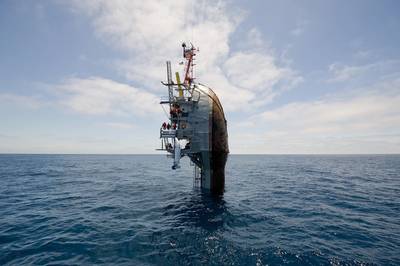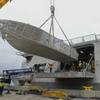US Navy-owned FLIP Research Platform Retired from Service
A dynamic era in naval oceanography recently ended as the iconic Floating Instrument Platform — popularly known as FLIP — was officially retired from service.
Built in 1962 with funding from the Office of Naval Research (ONR), FLIP helped generations of scientists and oceanographers better understand the mysteries of the sea, including internal waves, air-sea interaction and long-range sound propagation. Sadly, age and exorbitant life-extension costs resulted in the platform being disestablished.
On Aug. 3, a solemn gathering of well-wishers watched as FLIP was towed, at sunset, to a dismantling and recycling facility. Last month, a formal good-bye ceremony was hosted by the Marine Physical Laboratory at the University of California, San Diego (UCSD).
Still, FLIP — which was owned by the U.S. Navy and managed by Scripps Institution of Oceanography at UCSD — boasts a proud legacy and represents a golden age of oceanography that saw a renewed focus on ocean exploration, the creation of new fields of study, and greater public appreciation of the scientific and strategic importance of the ocean.
“Over its career, FLIP was a key mission enabler for ONR’s basic and applied programs in meteorology, oceanography and ocean acoustics,” said Dr. Thomas Drake, head of ONR’s Ocean Battlespace Sensing Department.
“Whether investigating air-sea interaction, ocean mixing, boundary layer dynamics or acoustic thermometry, FLIP’s unique properties and capabilities enabled the collection of exquisite datasets that served as the gold standard for numerous process studies and extensive model development, ultimately increasing our understanding of the maritime environment.”
Shaped like a spar buoy, the 355-foot FLIP resembled a giant baseball bat. When horizontal, FLIP was towed out to sea where on-board hydraulics and ballast tanks “flipped” the platform (in about 30 minutes) to the vertical — producing a stable, mobile at-sea experimental laboratory, capable of riding out swells while providing sensor data 300 feet into the water column.
FLIP could carry a research team of 11 people and a crew of five, and sustain research operations for up to 30 days without resupply. Also, everything mounted on the platform turned 90 degrees when it “flipped” at sea. All fixtures — from generators to toilets — turned at right angles, and there were separate passageways, doors and platforms for every major space inside and outside.
Because FLIP had no propulsion system of its own, it had to be towed by ship to a location. This quiet design made FLIP perfect for recording ocean acoustics and sounds as well as observing tidal forces, internal waves and small-scale turbulence. Such data gathering fostered greater knowledge of ocean currents and acoustics, air-sea interactions and marine mammal sounds.
In addition, FLIP was crucial to groundbreaking naval basic and applied research, much of which was sponsored by ONR. This includes oceanography, meteorology, ocean acoustics and the development of hydrophones (underwater microphones) — as well as how the upper part of the ocean interacts with the lower part of the atmosphere and how that interface affects things like sonar.
Another aspect of FLIP’s design that enabled it to be relevant for six decades was its lack of built-in sensors that could become obsolete. This allowed generations of researchers and scientists to install cutting-edge equipment and technology for testing.
Retired Scripps physical oceanographer Dr. Rob Pinkel logged many hours on FLIP cruises, starting in 1969 as a graduate student.
“In total, I spent about three years at sea aboard FLIP over the course of my career,” he said. “I enjoyed working with the crew and my research group to achieve something special. When all of the instruments were performing properly and the data were coming in, it was like operating a very rich gold mine.”
Naval Postgraduate School Professor Dr. Qing Wang led an ONR-sponsored research cruise aboard FLIP in 2017 to study air-sea interaction: “FLIP was such an impressive research platform that enabled us to do very detailed, thorough work. It truly was a game-changer in terms of naval scientific research and will be missed.”
Rob Sparrock, a program officer in ONR’s Oceanographic Research Facilities division, said, “Losing FLIP is unfortunate, but the loss will be mitigated by new unmanned assets and networks of smaller buoys being developed. FLIP’s legacy also lives on in current research platforms such as the French Polar POD, whose design is inspired by FLIP.”
Though retired, FLIP will live on at Scripps. One of its booms (crane-like arms for suspending instruments) will be installed on the Scripps research pier in La Jolla and used to deploy instruments. Also, artifacts from the platform will be displayed in a permanent exhibit at Scripps’ Birch Aquarium.











